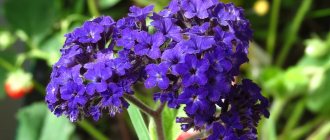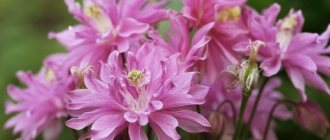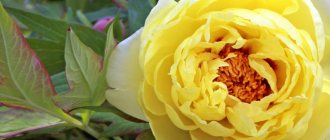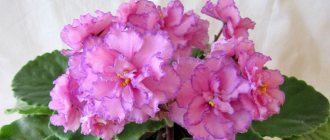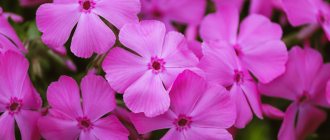Characteristics of hybrid petunia.
- Hybrid Petunias are members of the nightshade family.
- Hybrid petunias have a small sticky fluff.
- Stems come in three types: 1) branched, 2) erect, 3) creeping.
- The leaves are usually green in color and shaped like an oblong egg.
- Gardeners love petunias for their long bloom time and beautiful flowers.
- Flowers bloom gradually as shoots develop and emerge from the leaf axils.
- The flowers are shaped like a funnel and are usually divided into five petals.
- Pollination of petunia occurs with the help of moths and often very large ones.
- The fruit is a capsule containing several seeds.
- In general, Hybrid Petunias are perennials, but they are often grown as an annual plant.
- Petunias have many varieties, and breeders often invent new ones.
There are two main varieties of petunias - cascading , whose shoots are very long, and hanging ones , which create carpets of flowers.
Filigree cousins are also sometimes distinguished; the name was given in honor of the person who created this variety. The plants are very small and attractive looking.
What types of petunias are there?
Let's look at several specimens and their characteristic features.
The first specimen is a mixture of colors and its characteristic features.
- The mixture of colors is represented by large bushes.
- The height of each is about thirty-five to forty centimeters.
- Flowers with wavy petals and different colors.
The second example is a charming waterfall and its characteristic features.
- One of the popular cascade forms is a charming waterfall, the average height is up to sixty-five to seventy centimeters.
- The flowers are satiny and the plants are weather resistant.
The third copy is Evening sunshine, and its characteristic features.
- Evening sunshine, represented by small bushes.
- The average height is fourteen to fifteen centimeters.
- The flowers have a sky blue hue.
- The diameter of each inflorescence is about four to five centimeters.
- Loves light very much.
- Tolerates drought well.
The fourth copy is trilogy, and its characteristic features.
- Creeping petunia trilogy, average height about twenty-two to twenty-three centimeters.
- Flowers come in different shades. This variety is often used to create flower carpets.
The fifth copy is Big lapa sophistry barking, and its characteristic features.
- Big lapa sophistry lime. Bushes about twenty-five to thirty centimeters high.
- The flowers have a double color. Colors may be completely different.
- The plant is neutral towards the soil.
The sixth specimen is Mother, and its characteristic features.
- Mother small variety.
- The second characteristic feature of this variety.
- The flowers are bright purple. The diameter of one flower is about seven to eight centimeters.
- They tolerate diseases well.
The seventh copy is Loyalty, and its characteristic features.
- Fidelity is also a small variety with salmon-colored flowers.
- The diameter of one flower is about five to six centimeters.
- Flowering returns after rains.
The eighth copy is Star Rain, and its characteristic features.
- Star Rain, a representative of the densely branched species of petunias.
- The leaves are narrow.
- The average height of the bush is twenty-five to thirty centimeters.
- The flowers resemble stars, usually bright pink or purple.
The ninth copy is Laguna, and its characteristic features.
- Lagoon, the height of the bushes is up to thirty to thirty-five centimeters.
- Large flowers come in completely different colors.
- The diameter of one flower is fourteen to fifteen centimeters.
The tenth copy is tango, and its characteristic features.
- Compact bushes up to twenty-five to thirty centimeters high are called tango.
- The flowers are bright pink.
- The diameter of one inflorescence is about seven to eight centimeters.
The eleventh copy is Isabella, and its characteristic features.
- Isabella has meter-long stems.
- The flowers are crimson and quite large.
- Resistant to diseases.
The twelfth specimen is Few the blues lime coral, and its characteristic features.
- Thick, lush, average height is about thirty-five to forty centimeters.
- The flowers are yellow and large.
The thirteenth specimen is Pendolino rose eye, and its characteristic features.
- The flowers are pink.
- The diameter of one inflorescence is about two centimeters.
- The height of the bush is approximately fifteen to twenty centimeters.
- The plant tolerates low and high temperatures well.
The fourteenth copy is Capella, and its characteristic features.
- The chapel is represented by small bushes.
- The height of each is about fifteen to twenty centimeters.
- The average diameter of the flowers is about nine to ten centimeters, the center is purple, the border is white.
The fifteenth specimen is Carolina, and its characteristic features.
- Carolina is a representative of upright petunias.
- The growth of one bush is fifteen to sixteen centimeters.
- The flowers are quite large, about twelve to thirteen centimeters in diameter.
- Damp, acidic soils will be detrimental to the plant.
Representation of the hybrid petunia variety.
Let's consider the characteristic features of this variety.
Hybrid petunias are descendants of wild petunias from South America.
Flower growth largely depends on the variety, with an average of twenty-five to thirty centimeters.
Petunias bloom throughout the season until the onset of cold weather.
The palette of petal shades is huge. Flowers can be white, violet, pink, purple, cream and many other shades.
The best place to grow petunias is a place protected from winds and rain and well lit by the sun. There are varieties that tolerate wind well, but on balconies that are not protected by anything, it is better not to plant varieties that have small flowers.
To ensure that the flowers do not begin to shrink during flowering and that flowering occurs on time, it is necessary to provide the plants with proper lighting.
How to properly care for petunias?
Let's look at a few recommendations for caring for this variety.
In order for Hybrid petunias to bloom well and for a long time, they need a lot of soil. Flower soil containing fertilizers is used as the main soil. From these fertilizers, the plant will receive nutrients at the beginning of its life, but in the future it will have to be fed.
There are two simple rules for caring for petunias.
Firstly the soil should not be allowed to dry out. If the soil dries out, the risk of insects and diseases will increase and the petunias will not be able to recover completely.
When the summer heat hits, it is necessary to water the plants twice a day. It is better to do this during the day and with warm water. Leaves should not cool suddenly at night, as this can harm the plants.
The second rule is the right fertilizers. To apply fertilizer as correctly as possible, it is better to do this during each watering. Choose the dose recommended by the manufacturer and divide it into a certain number of days and fertilize the plants every day.
You can choose a package that gives a seven-day dosage, divide it into seven days and give the plant a little each day. This method will be better than transferring fertilizers. Fertilizers should be in light form, accessible to plants.
Petunias love acidic soil. If the plant grows in a pot, then the acidity will decrease very quickly. When the alkalinity of the soil becomes elevated, the flowers and leaves gradually begin to turn yellow. This is due to the fact that iron in alkaline soils is poorly absorbed.
Plants can also be grown in open ground. Any variety can be grown in open ground.
For flower pots, you can use stands in the form of trees. You can order wooden coasters from a locksmith or find them in a specialty store. If you place petunias in such a structure, you need to remember about watering, it can either be automatic or from the topmost to the lowest plant.
Reviews from gardeners
Frodo, Tolyatti
You buy the very first petunia, then plant it at home in a large pot and place it on the window, feed it, and after two weeks you have not one plant, but 10, and in the house it grows 20 times faster than outside, the main thing is that there is light .
Source: forum.tvoysad.ru
Lobelia, Zhukovsky
There were good results when feeding AVA for balcony flowers. Petunia loves to eat, but potassium-phosphorus “food”.
Source: www.forumhouse.ru
How to grow seeds?
Gardeners usually buy ready-made petunia seedlings. If you grow seedlings yourself, no one guarantees that the result will be of high quality. Let's look at a few recommendations for growing this variety from seeds.
The soil in which petunia seeds are sown is special. Seedlings are very sensitive to fungi, so they should not be in the ground, just like weed seeds. When the seeds begin to germinate, average temperatures should be around twenty-one degrees around them. With the gradual germination of the plant, it is necessary to reduce the temperature to seventeen to eighteen degrees.
The picking process begins when the first leaves appear on the plants.
Seedlings should be removed once every two weeks.
The process of seed dispersal is lengthy. It starts in January.
In order for seedlings to grow well indoors, they need to be illuminated.
In the spring, before planting in open ground or an outdoor pot, you need to harden it.
At the end of summer, petunias can be propagated using cuttings.
It is recommended to use, root or move the cuttings for several weeks to a dark place where the air temperature will be lower so that the roots begin to sprout. When the roots are formed, each bush is formed, place it in a separate pot; in winter they can be grown at home.
Diseases and pests
The main diseases that arise mainly due to non-compliance with agricultural practices:
- chlorosis;
- powdery mildew;
- blackleg;
- late blight
Systemic fungicides are used to treat petunia. But if the bush is extensively damaged, it has to be dug up by the roots, since there is no chance that the petunia can be cured, but there is a risk of the fungus spreading to other plantings.
Insects that can infect petunia are aphids, spider mites, thrips. If pests are found on the bushes, insecticides are used.
Diseases that often attack petunias.
What diseases and pests attack petunias?
The varieties of petunias appearing now are more resistant to various diseases. If diseases occur, you can spray the plants with fungicides. Spraying will be quite difficult due to the fact that the plant has many flowers and shoots. It will be difficult to treat all infected areas.
The first disease is Petunia Mosaic.
- The stems of the shoots begin to darken and become covered with spots.
- This disease is inherent in plants grown by cuttings.
- Flowering with this disease weakens and the plants gradually dry out.
- The virus is not transmitted through seeds, so they can be pulled out if possible.
The second disease is Alternaria.
- If white spots appear on the petals, this may be a sign of Alternaria blight.
- In the advanced stage of the disease, black stripes will appear on the stems.
The third disease is late blight.
- Late blight appears from the soil. Gradually, the plants begin to turn yellow from below and the leaves fall off.
The fourth disease is chlorosis.
- When a plant lacks iron or the soil is too acidic, chlorosis can occur. Fertilizers with a high ferrum content will help cure this disease, but it will be difficult.
Crazytunia Cosmic Purple
Petunia Crazytunia Cosmic Purple appeared on the flower market just a few years ago, in 2022, and immediately won the hearts of petunia lovers. The reason is the rare and incredibly beautiful color of the flowers. In the center of the five-petal flower is a star of rich purple color. The rest of the petals are lighter, raspberry pink.
Petunia Crazytunia Cosmic Purple belongs to the ampelous species. The bush has a spherical shape and requires almost no shaping. Plant height is 20-30 cm, shoot length is 45 cm. Crazytunia Cosmic Purple forms dense lush bushes strewn with a large number of flowers with a diameter of about 5 cm. Flowering is early, abundant and long-lasting. Prefers sunny places.
Petunia Crazytunia Cosmic Purple is resistant to adverse weather conditions. Ideal for growing in containers and hanging pots.
How can you use petunias?
Hybrid petunias can decorate almost anything; they are often planted in hanging pots, cache-pots, used to decorate flower beds, parks, houses, plots and much more.
Petunia looks good in vertical flower beds.
Hybrid petunias are often used in landscape design and can be grown as a houseplant.
Bicola F2 (Bicola F2)
Another two-color petunia looks unusual - the hybrid Bicola F2. It belongs to the ampelous plants. The central shoots of the bush grow upward, but most of the vines take on a drooping shape as they grow. The longest hanging shoots grow up to 30-45 cm in length. This hybrid is perfect for decorating flower beds, as well as for growing in pots and hanging baskets.
The flowers of petunia Bicola F2 are large, double, with wavy edges. The petals are cherry-colored. There is a white border along the edge of each petal.
Petunia Bicola F2 blooms for a long time: the first buds open at the end of May - June, and new ones appear regularly until frost.
- Ampelous petunia: to prune or not?
How does ampelous petunia differ from “regular” petunia and does it need to be pruned? Let's try to figure it out together!
